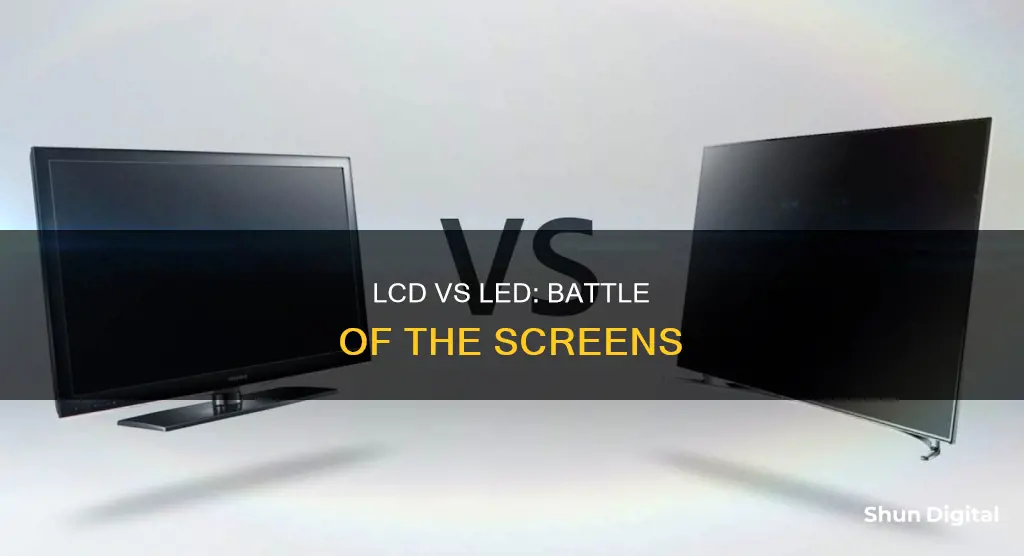
When it comes to monitors, there are two main types of display technologies: LCD (Liquid Crystal Display) and LED (Light-Emitting Diode). While they may seem similar, there are significant differences between the two. LCD monitors use liquid crystals to control the passage of light, while LED monitors use light-emitting diodes for backlighting. LED monitors offer superior picture quality, with better contrast ratios, improved colour accuracy, and deeper blacks. They are also more energy-efficient and have a longer lifespan. However, LCD monitors are more affordable and provide good image quality, making them a popular choice for budget-conscious consumers. When deciding between an LCD and LED monitor, consider factors such as purpose, budget, energy efficiency, picture quality, and screen size to determine which technology best suits your needs.
| Characteristics | Values |
|---|---|
| Display type | LCD is a display type, LED is a backlight for a display |
| Backlighting | LCD uses cold cathode fluorescent lamps (CCFLs) for backlighting; LED uses light-emitting diodes |
| Image quality | LED displays have better colour accuracy, contrast, and brightness than LCD displays |
| Energy efficiency | LED displays are more energy-efficient than LCD displays |
| Cost | LCD displays are more affordable than LED displays |
| Maintenance | LED displays are easier to maintain than LCD displays |
| Lifespan | LED displays have a longer lifespan than LCD displays |
| Response time | LED displays have faster response times than LCD displays |
| Refresh rate | Both LCD and LED displays can offer high refresh rates |
| Eye comfort | LED displays have better brightness control and reduced flicker, but LCD displays have better colour accuracy and a wider colour gamut |
What You'll Learn
- LED monitors use light-emitting diodes for backlighting, while LCD monitors use cold cathode fluorescent lamps
- LED monitors are thinner, lighter, and more energy-efficient than LCD monitors
- LED monitors have better colour accuracy and contrast ratios than LCD monitors
- LED monitors are more expensive than LCD monitors
- LED monitors are better for gaming due to higher contrast ratios, faster response times, and local dimming capabilities

LED monitors use light-emitting diodes for backlighting, while LCD monitors use cold cathode fluorescent lamps
LED monitors and LCD monitors differ in their backlighting technology. LED monitors use light-emitting diodes for backlighting, while LCD monitors use cold cathode fluorescent lamps (CCFLs).
LCD stands for Liquid Crystal Display. This technology uses liquid crystals, which are substances with properties of both liquids and solids. When an electric current is applied, the liquid crystals align to either allow or block light, creating the images displayed on the screen. Traditional LCD screens use CCFLs placed behind the screen for illumination. These lamps serve as the light source, emitting light that passes through the liquid crystal layer to create images.
On the other hand, LED stands for Light-Emitting Diode. Unlike LCDs, LEDs utilise an array of semiconductor light-emitting diodes to produce light. Each diode emits light when an electric current passes through it, eliminating the need for a separate light source like CCFLs.
The use of LED backlighting offers several advantages over traditional CCFL backlighting. LED monitors are thinner and more lightweight, have shorter response times, and provide consistent brightness. Additionally, LED backlighting allows for more precise control over screen brightness and enables local dimming, resulting in improved contrast and black levels.
While CCFL backlighting provides uniform illumination and is more cost-effective, it is less energy-efficient, does not illuminate the screen as evenly, and is more challenging to repair and maintain.
Choosing the Perfect Monitor Size for Your Desk Setup
You may want to see also

LED monitors are thinner, lighter, and more energy-efficient than LCD monitors
When it comes to choosing a monitor, it's important to understand the differences between LCD and LED technologies. "LED" and "LCD" refer to different aspects of monitor technology, with "LED" pertaining to the backlighting and "LCD" to the display itself. All LED monitors are a type of LCD monitor, but not all LCD monitors use LED backlighting.
The thinner design of LED monitors is due to the use of two main types of backlighting: full-array backlighting and edge lighting. Full-array backlighting places LEDs evenly across the entire screen, allowing for local dimming and better contrast. Edge lighting, on the other hand, places LEDs only along the perimeter of the screen, resulting in thinner displays but potentially less uniform lighting. This edge lighting is a cost-saving measure that doesn't significantly impact image quality.
In addition to being thinner and lighter, LED monitors also offer improved visual clarity and colour accuracy. This is because LED backlighting provides superior LED displays with easier maintenance. The use of LED backlighting also results in a more consistent brightness across the screen, enhancing the viewing experience.
While LCD monitors with CCFL backlighting are typically more affordable, LED monitors provide significant advantages in terms of thinness, weight, energy efficiency, and visual clarity. These benefits make LED monitors a compelling choice for those seeking improved performance and a longer-lasting investment.
Choosing the Right Machine Screws for Monitors
You may want to see also

LED monitors have better colour accuracy and contrast ratios than LCD monitors
When it comes to colour accuracy and contrast ratios, LED monitors outperform LCD monitors. LED monitors offer superior picture quality, with deeper blacks and more accurate colours. This is because LED technology allows for better contrast and deeper blacks, resulting in a more dynamic image. LED monitors generally offer a wider colour gamut, allowing them to display a larger percentage of the sRGB and Adobe RGB colour spaces. This is especially beneficial for professionals in graphic design, photo editing, and video production, where colour accuracy is crucial.
LED monitors also have better control over screen brightness, which can help reduce eye strain. They often come equipped with customizable colour temperature settings, allowing users to adjust the display's blue light output to reduce eye fatigue. Additionally, LED monitors have faster response times, reducing motion blur and ghosting.
While LCD monitors may offer good colour accuracy, they often struggle to produce true blacks and can have lower overall brightness. However, LCD monitors with advanced technology, such as quantum dot displays, can rival LED monitors in terms of picture quality. LCD monitors are also more affordable and have more uniform backlighting across the entire screen.
Monitor Broadband Usage: Track Your Data Usage Easily
You may want to see also

LED monitors are more expensive than LCD monitors
The higher price point of LED monitors may be a deciding factor for those on a tight budget. However, it's important to note that the price gap between LED and LCD monitors has narrowed in recent years as LED technology has become more common and accessible.
While LED monitors offer enhanced performance and features, LCD monitors still provide good value and performance for those seeking a more affordable option. LCD monitors are sufficient for traditional computing tasks and can be suitable for gaming, especially if they have a high refresh rate. Additionally, LCD monitors often come with matte screens, which can be advantageous in reducing glare in bright environments.
Disassembling Your ASUS Monitor: A Step-by-Step Guide
You may want to see also

LED monitors are better for gaming due to higher contrast ratios, faster response times, and local dimming capabilities
When it comes to gaming, LED monitors offer a range of benefits that make them a superior choice over LCD monitors. One of the key advantages is the higher contrast ratios achieved by LED monitors. This means that LED monitors can display deeper blacks and brighter colours, resulting in a more immersive gaming experience.
LED monitors also boast faster response times, which is a crucial factor in reducing motion blur during gameplay. This ensures that gamers can enjoy smooth and seamless visuals, even during fast-paced scenes. Additionally, LED monitors often feature local dimming capabilities, which further enhance the contrast ratio and improve the display of dark scenes. By selectively dimming certain zones of LED lights, local dimming provides deeper blacks and improves overall picture quality.
The combination of higher contrast ratios, faster response times, and local dimming capabilities makes LED monitors ideal for gaming, especially in genres where reaction time is critical, such as first-person shooters. LED monitors provide gamers with a competitive edge by delivering crisp and clear visuals, ensuring that every millisecond counts.
It is worth noting that while LED monitors offer superior performance, LCD monitors still have their advantages, particularly in terms of cost. LCD monitors are often more affordable, making them a budget-friendly option for gamers who may not require the highest-end specifications. Additionally, LCD monitors with high refresh rates can still provide a good gaming experience, especially for those on a tighter budget.
Monitoring Memory Usage: NRPE Nagios Guide
You may want to see also
Frequently asked questions
LCD stands for Liquid Crystal Display, while LED stands for Light-Emitting Diode. LCD monitors use liquid crystals to control the passage of light, while LED monitors use light-emitting diodes for backlighting. All LED monitors are a type of LCD monitor, but not all LCD monitors use LED backlighting.
Both LCD and LED monitors can cause eye strain with prolonged use. LED monitors often have higher refresh rates and customizable colour temperature settings, which can help prevent eye strain. LCD monitors tend to have better colour accuracy and a wider colour gamut, making them ideal for graphic design work.
LED monitors are generally better for gaming due to their higher contrast ratios, improved colour accuracy, and faster response times. However, a high-quality LCD monitor with a high refresh rate can still provide a good gaming experience.
LCD monitors are typically more affordable than LED monitors, making them a good choice for budget-conscious consumers.







